Capt. Dale “Snort”Snodgrass
Gaining Positional Advantage
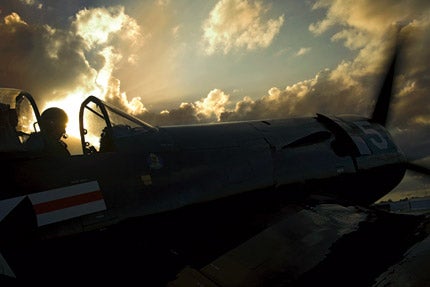 Captain Dale "Snort" Snodgrass (U.S. Navy, ret.), former Top Gun instructor, legendary F-14 Tomcat pilot and current air show superstar, is politely considering a question he's likely been asked many times before: What's the "right stuff" all about?
Captain Dale "Snort" Snodgrass (U.S. Navy, ret.), former Top Gun instructor, legendary F-14 Tomcat pilot and current air show superstar, is politely considering a question he's likely been asked many times before: What's the "right stuff" all about?
"You're in a place that you know you were designed to be in," Snodgrass says. "You get in an airplane---I just know that's where I'm supposed to be. There's nothing else I'd be more at home in. And everything clicks in for me, particularly the tactical stuff---the dogfighting stuff. I see things happening six moves ahead. All this while you're at 8 G's and 500 knots, and you're flying against multiple airplanes. It's the ability to sort of ’get in the zone' and execute that."
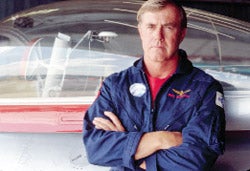 We're sitting in the Fly By Café overlooking the runways at St. Augustine Airport (SGJ) in Florida, Snodgrass' home base.
We're sitting in the Fly By Café overlooking the runways at St. Augustine Airport (SGJ) in Florida, Snodgrass' home base.
"It's just very natural. Even the very first time I tried it, it just worked out," Snodgrass continues. "I don't know how that works. Some people are lucky enough to get in such a position."
Whether getting his pipper stabilized on a MiG 25 over the Gulf of Sidra or managing to get into the cockpit of an assortment of jet fighters and big piston warbirds on the air show circuit, Snodgrass has demonstrated an ability to maneuver into the advantageous position. But listening to the soft-spoken überpilot, one has to conclude that luck has less to do with it than, well, having the right stuff: the ability to think a few steps ahead---whether in the air or on the ground.
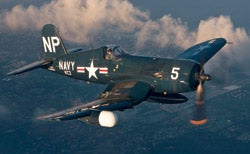 |
| Listening to the soft-spoken überpilot, one has to conclude that luck has less to do with it than, well, having the right stuff... |
The son of a Grumman test pilot, Snodgrass grew up on Long Island, N.Y. He earned his wings and commission through the Naval ROTC program at the University of Minnesota, which he attended on a swimming scholarship. Suffice it to say he distinguished himself as an exemplary pilot in training, was the first student selected to fly the new F-14 and became the Navy's top Tomcat pilot. He could push the envelope hard because, somehow, he always knew where the edges were. He led his squadron into combat in Desert Storm, was given charge of all F-14 demo operations and ultimately rose to be in command of every F-14 in the nation's active inventory.
Unlike most former fighter pilots, however, Snodgrass hasn't had to leave the hot planes behind. In one of his hangars at St. Augustine, a P-51 Mustang and an F4U-5NL Corsair are chocked side by side. A little later today, he'll be taking the Corsair up for a photo mission. The F-86 Sabre he uses in air shows is in Texas having its engine overhauled. And this season, having added a supersonic Northrop F-5 Tiger II fighter to his arsenal, Snodgrass will present "the first ever civilian F-5 air show."
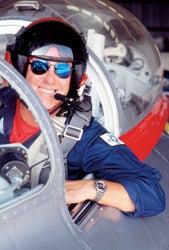 |
| Dale Snodgrass' career began at the Naval ROTC program at the University of Minnesota. Eventually, he became the Navy's top Tomcat pilot. After leading his squadron in Desert Storm, he rose to be in command of every F-14 in the nation's active inventory. |
The roots of his success in the air show world go back to his stint as an F-14 demonstrator. "The military made that transition for me," Snodgrass says of his air show career. "They said, ’Dale Snodgrass, you're going to be an F-14 demo pilot.' I flew F-14 demos on and off for 12 years. I started developing the skill sets and the qualifications to continue in [the civilian] arena in the mid-1980s. I knew the place I wanted to go was flying the high-priced warbirds on the air show circuit."
As a military demo pilot, Snodgrass was known for his flashy performances. An iconic picture of the F-14 shows one roaring past an aircraft carrier, knife-edged, looking like it's 10 feet from the side of the ship. That's Snort in the front seat, performing a demo for the fleet.
It's probably natural to assume a hotshot fighter pilot like Snodgrass can just hop into a warbird and become a civilian air show star. But it takes more than flying skills to get into the right position for that.
"You can't just walk up to somebody and say, ’Hey, I'm Charlie Dickens, world-famous F-16 pilot. I should be able to fly airplanes,'" says Snodgrass. "I know a lot of the Air Force demo guys would love to be able to shift over and fly the civilian side of the house when they get out. Most of the guys have the skill sets. [But] you have to develop a relationship and rapport with someone who has the airplanes and is willing to allow you to fly them. You have to make that connection however you can---there's no set formula." And Snodgrass concedes that it's getting harder all the time.
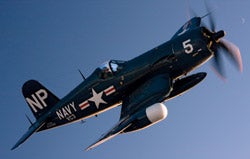 "The increased cost of the airplanes, the exponential rise in the cost of insurance and the high operating costs [mean] that nobody's just going to give you the keys unless they really love you for some reason," he comments.
"The increased cost of the airplanes, the exponential rise in the cost of insurance and the high operating costs [mean] that nobody's just going to give you the keys unless they really love you for some reason," he comments.
Early on, Snodgrass realized part of the key to becoming PIC of a vintage warbird was having significant tailwheel time.
"So I bought a Super Decathlon, and I had great success with that airplane," Snodgrass says.
Meanwhile, on the air show circuit, Snodgrass became friends with pilots from the Kalamazoo Aviation Historical Museum (now renamed the Air Zoo, www.airzoo.org), which owned several warbirds flown in air shows. Snodgrass began flying with them when he was off duty, working his way up from the North American T-6 Texan trainer to the Chance Vought Corsair and then to the North American P-51 Mustang.
"That's how I got into the big piston world," he says, summing up his lateral career move.
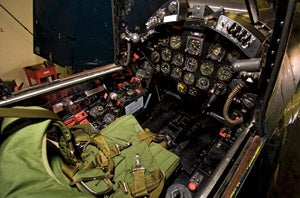 |
| The F4U-5NL Corsair that Snodgrass flies was built in 1952 and was based on the U.S.S. Essex during the Korean War. |
After 26 years in the Navy, Snodgrass had risen to the rank of captain and amassed more F-14 time---some 4,800 hours---than any other pilot. His next promotion would likely have been to admiral, trading in his jets for a desk.
"The corporate life---I guess that's how you'd describe it---the jobs that I would have had weren't really enticing to me," Snodgrass says.
Fortunately, he was in a position to opt out of the service. He resigned his commission in 1999.
"When I left the Navy, I was in the right place on the air show circuit, with the ability to fly high-priced warbirds," Snodgrass says.
The sun is a little lower in St. Augustine. We've driven over to Snodgrass' hangar. The bifold door is open, and the P-51 and Corsair stare out, big diamonds in a tin can. The Corsair, wings folded like a butterfly, dwarfs the Mustang. The F4U had the largest engine and propeller ever mounted on a fighter up to that time: a 2,000 hp Pratt & Whitney R-2800 Double Wasp radial and a 13-foot, four-inch Hamilton Standard Hydromatic prop. The inverted gull wings, designed to accommodate the arc of the prop, are the Corsair's signature feature.
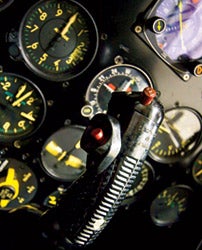 |
| The 5NL incorporates electrical controls for its systems, including elevator and rudder trim, cowl flaps and intercooler doors. |
With an assist from a pickup truck, Snodgrass' ground crew pulls the Corsair out of the hangar and readies it for flight. This model---Corsair Bureau Number (BuNo) 124692---is owned by the Collings Foundation (www.collingsfoundation.org), an aircraft and auto preservation organization based in Stow, Mass.; it was restored by American Aero Services (www.americanaeroservices.com) of New Smyrna Beach, Fla. Snodgrass did the initial flight-testing following its restoration in 2003. It's an F4U-5NL; the "Dash 5" variant was outfitted with a more powerful Pratt & Whitney R-2800-32(E) engine, increasing the horsepower to 2,450. It also incorporated electrical controls for many systems that were previously manually operated, including elevator and rudder trim, cowl flaps and intercooler doors.
"They tried to make this more jet-like," Snodgrass says of the Dash 5. "So they made all the systems electrical---which probably cost them. The early electrics weren't as good. You know, wires broke, and in more than one case, the trim ran away or wouldn't work."
"NL" designates night fighter. The exhaust stacks are outfitted with flash plates to prevent incandescent exhaust gas from ruining the pilot's night vision. This Corsair was built in 1952, the year before production ended, and was based aboard the U.S.S. Essex during the Korean War, hunting adversary aircraft in extreme conditions.
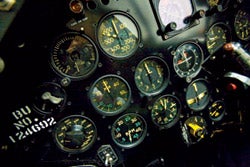 |
| During his air show routine, Snodgrass glides down at max continuous climb power, reaching indicated air speeds of 350 knots. |
Snodgrass' typical Corsair air show routine, similar to his Mustang performance, commences with an air start "at 3,000 or 4,000 feet [AGL]," Snodgrass says. "I glide down at max continuous climb power and reach indicated air speeds of about 340 to 350 knots. Then I'll pull to vertical and I'll just drive on what we call the vertical up line---I'll get to about 4,500 feet."
This attention-grabbing intro leads into a sequence including loops, rolls, Cuban 8s and vertical dives and pulls, demonstrating the Corsair's power, speed and maneuverability. As in his military days, Snodgrass is still a flashy performer.
For the past seven years, Snodgrass has also been flying a North American F-86 Sabre on the air show circuit. The simple swept wings and the compact size of this early transonic fighter bring back memories of the Cold War and air-to-surface engagements against Godzilla.
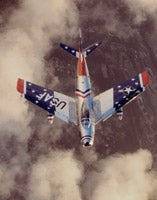 "The F-86 is, as a pure airplane, one of the nicest I've ever flown," Snodgrass asserts. "It has wonderful flying qualities and no bad habits, plus the controls are very light. When you sit in it, you know you're in a fighter."
"The F-86 is, as a pure airplane, one of the nicest I've ever flown," Snodgrass asserts. "It has wonderful flying qualities and no bad habits, plus the controls are very light. When you sit in it, you know you're in a fighter."
After searching for a newer model, Snodgrass reached an agreement with the Cavanaugh Flight Museum (read "Cavanaugh's Flight Through Time") in Addison, Texas, to use its F-86 Canadair Sabre Mark 6 (designated as a CL-13 and made under license from North American). The Canadair Sabre has an Avro Canada Orenda turbojet engine, developing 7,200 pounds of thrust, in place of the 5,200-pound thrust General Electric J47-GE-13 used in the F-86A. "In my opinion, it's probably the ultimate F-86," Snodgrass says of the Canadair Sabre.
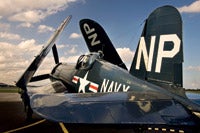 Even as he continues his air show career, Snodgrass is positioning himself to move into the worlds of cyberspace and television. His American Topgun Productions (ATG, www.americantopguns.com) is developing American Topgun Challenge computer simulation games with Microsoft that will enable virtual pilots to compete in a series of air combat challenges, based on real-world carrier operations. ATG is also developing a reality TV show, a celebrity dogfighting competition Snodgrass describes as "a cross between Survivor and Dancing With The Stars." And down the road, winners of sim games might get to compete in the reality TV show.
Even as he continues his air show career, Snodgrass is positioning himself to move into the worlds of cyberspace and television. His American Topgun Productions (ATG, www.americantopguns.com) is developing American Topgun Challenge computer simulation games with Microsoft that will enable virtual pilots to compete in a series of air combat challenges, based on real-world carrier operations. ATG is also developing a reality TV show, a celebrity dogfighting competition Snodgrass describes as "a cross between Survivor and Dancing With The Stars." And down the road, winners of sim games might get to compete in the reality TV show.
"It helps out the air show," Snodgrass adds, "so it's a very cool way of tying all of these different spaces together homogeneously and symbiotically."
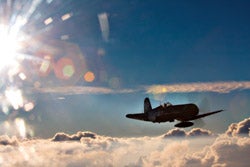 The Corsair is ready. This end of the airport is always quiet, but somehow a small knot of onlookers has materialized to ogle the warbird. After a walk-around inspection, Snodgrass hoists himself up the side of the fuselage and into the cockpit. With a roar and a lot of smoke, the big prop starts swinging, wings still folded. The golden glow of the late-afternoon sun catches Snodgrass in his perch atop the hulking machine. Any aviator would have to wonder: Could there be any better position to be in?
The Corsair is ready. This end of the airport is always quiet, but somehow a small knot of onlookers has materialized to ogle the warbird. After a walk-around inspection, Snodgrass hoists himself up the side of the fuselage and into the cockpit. With a roar and a lot of smoke, the big prop starts swinging, wings still folded. The golden glow of the late-afternoon sun catches Snodgrass in his perch atop the hulking machine. Any aviator would have to wonder: Could there be any better position to be in?

Subscribe to Our Newsletter
Get the latest Plane & Pilot Magazine stories delivered directly to your inbox





